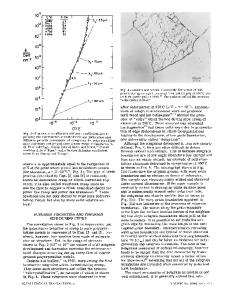Subgrain growth in aluminum during static annealing
- PDF / 220,395 Bytes
- 2 Pages / 594 x 774 pts Page_size
- 50 Downloads / 354 Views
Purdy, and J.D.
E m b u r y : Can. Met. Quart.,
1981, vol. 20, pp. 339-50. 2. P. Wycliffe,G. R. Purdy, and J. D. Embury: in Fundamentals of DualPhase Steels, R.A. Kot and B.L. Bramfitt, eds., TMS-AIME, Warrendale, PA, 1981, pp. 59-83. 3. G.R. Speich, V.A. Demarest, and R.L. Miller: Metall. Trans. A, 1981, vol. 12A, pp. 1419-28. 4. M. Charest: Division Report MRP/PMRL 79-45E(TR), CANMET, Energy, Mines and Resources Canada, 1980. 5. K. Nohara and K. Hirano: Proc. ICSTIS, Suppl. Trans. ISIJ, 1971, vol. 11, pp. 1267-72. 6. G. R. Purdy, D.H. Weichert, and J. S. Kirkaldy: Trans. TMS-AIME, 1964, vol. 230, pp. 1025-34. 7. P.A. Wycliffe: Ph.D. Thesis, McMaster Univ., Hamilton, Canada, December 1981.
Subgrain Growth in Aluminum during Static Annealing S.K. VARMA and BARRY L. WILLITS The formation of cells or subgrains in aluminum is easy during the deformation due to its high stacking fault energy. The cold worked microstructure containing subgrains has to undergo subgrain growth during its subsequent static annealing process before recrystallization can occur. The kinetics of subgrain growth in static annealing has been theoretically studied by Sandstrom L2 and the results were later confirmed by him and his co-workers 3 on pure aluminum and AI-1 pct Mn alloy. Sandstrom et alfl used a bar for the study that had been cold rolled to 80 pct reduction in thickness. They were able to show that subgrain size increases parabolically as a function of time at a given temperature during static annealing by in situ experiments in HVEM. The mechanisms proposed by the authors indicate that the subgrain growth occurs by dissolution of subgrain boundaries (coalescence) and boundary migration at lower and higher recovery temperatures, respectively. However, the effect of changing the initial cold worked microstructure on the mechanism s of subgrain growth in annealing has not yet been studied. This fact becomes especially important in the case of pure aluminum where a saturation in cell size is reached quickly during the deformation 4,5 and similar cell sized samples having undergone different amounts of dynamic recovery can be obtained. Also, as pointed out by the authors 3 themselves, the subgrain growth could have been affected by the small thicknesses that could be examined even in HVEM as compared with bulk materials. Thus, research has been initiated at our institution to study the subgrain growth in pure aluminum during annealing and this note presents the preliminary results on bulk aluminum wires that were quenched in water from the annealing temperatures, and the microstructures were observed by a conventional TEM method. Aluminum of four nines purity was used for the study, and the spectrographic analysis based on weight percent and
details of wire drawing process have been described 4 elsewhere. The annealing of samples with a true wire drawing strain of 1.25 was carried out in a salt bath at 250 ~ for different lengths of time. Samples were quenched in water after each annealing treatment. The wafers were cut from the tran
Data Loading...











